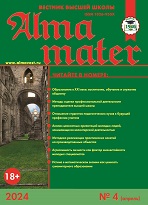UDC 378:316.4
https://doi.org/10.20339/AM.09-21.028
T.V. Ledovskaya is Cand. Sci. (Psychology), Ass. Prof. at Department of Pedagogical Psychology e-mail: karmennnn@yandex.ru; and A.V. Afanasov is Cand.Sci. (Pedagogy), Ass. Prof. at Department of Social Pedagogy and Organization of Work with Youth e-mail: a.afanasov@yspu.org. Both at Yaroslavl State Pedagogical University
Elaborated is the content of the concepts of “anxiety” and “adaptation”. The dynamics of neuropsychiatric stability, situational anxiety and adaptation in students during the initial period of study at the university were revealed. During the adaptation period, reactive anxiety changes in the direction of its increase. The presence of the relationship of adaptive abilities and anxiety in students in 1–3 semester of study is shown. There is an increased interaction of these mental phenomena among themselves in 1st semester. During the adaptation period, the level of statistical connection between reactive anxiety and communicative abilities increases. Moral normality is a situational characteristic during adaptation and its relationship with personal and reactive anxiety is weak, but tends to increase. Most students successfully overcome the initial period of study, but the values of personal adaptation potential in students lie in the zone of “reduced adaptation”, that is, the adaptation process is in a positive direction, but it is difficult. In order for a student to effectively pass the adaptation period, he needs to increase the level of communicative abilities and neuropsychiatric resistance. This will reduce anxiety to the optimal level.
Key words: anxiety, adaptive abilities, students, interdisciplinary, neuropsychiatric stability, stress.
References
- Bottesi, G., Martignon, A., Cerea, S., Ghisi, M. Worry and associated cognitive features in Italian university students: Does gender make a difference? Personality and Individual Differences. 2018. Vol. 126. P. 38–43. URL: https://doi.org/10.1016/j.paid.2018.01.016
- Lopez-Fernandez, O., Rodriguez-Illera, J.L. Investigating university students’ adaptation to a digital learner course portfolio. Computers & Education, Vol. 52. Iss. 3. 2009. P. 608–616. URL: https://doi.org/10.1016/j.compedu.2008.11.003
- Lukács, A. The impact of physical activity on psychological well-being and perceived health status during coronavirus pandemic in university students. Journal of King Saud University — Science. 2021. URL: https://doi.org/10.1016/j.jksus.2021.101531
- Tavakoli, N., Broyles, A., Reid, E.K., Sandoval, J.R., Correa-Fernández, V. Psychological inflexibility as it relates to stress, worry, generalized anxiety, and somatization in an ethnically diverse sample of college students. Journal of Contextual Behavioral Science. 2019. Vol. 11. P. 1–5. URL: https://doi.org/10.1016/j.jcbs.2018.11.001
- Wijesooriya, N.R., Mishra, V., Brand, P.L.P., Rubin, B.K. COVID-19 and telehealth, education, and research adaptations. Paediatric Respiratory Reviews. 2020. Vol. 35. P. 38–42. URL: https://doi.org/10.1016/j.prrv.2020.06.009
- Postovalova, G.I. Psychological and socio-psychological features of student adaptation. Moscow: Azimuth Center, 1993. 229 p.
- Prikhojan, A.M. Reasons, prevention and overcoming anxiety. Psychological science and prevention. Moscow: Science, 1998. 200 р.
- Smirnov, A.A., Zhivaev, V.G. Psychology of university adaptation. Yaroslavl: YARGU, 2009. 115 p.
- Solynin, N.E., Lebedeva, E.P. Psychological causes of anxiety in adolescence. Yaroslavl Pedagogical Bulletin. 2016. No. 6. Р. 281–284.
- Sorokina, Yu.L. Overcoming the crisis of educational adaptation by students of a pedagogical university: Abstr. diss. ... cand.psychol. sciences. Yaroslavl, 2005.
- Spielberger, C. Conceptual and Methodological Problems of Anxiety Research. In: Anxiety and Anxiety: texture. St. Petersburg: Per Se. 2008. P. 85–99.











.png)






